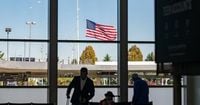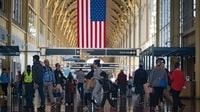Travelers across the United States breathed a collective sigh of relief this week as the Department of Transportation and the Federal Aviation Administration (FAA) announced that flight reductions at 40 major airports would remain capped at 6%, rather than increasing to the previously planned 10%. The move comes amid a dramatic turnaround in air traffic controller staffing, as the nation’s longest government shutdown finally drew to a close.
On Wednesday, November 13, 2025, as Congress took decisive steps to end the 43-day federal government shutdown, the Department of Transportation revealed that a “rapid decline” in air traffic controller callouts had prompted the FAA to freeze further flight cuts. According to Reuters, the Trump administration’s emergency order reversed earlier plans to escalate flight reductions to 8% on Thursday and 10% on Friday. Instead, the 6% cap will remain in place “as the FAA continues to assess whether the system can gradually return to normal operations,” the agency stated.
The shutdown, which began on October 1, 2025, had left thousands of federal employees—including air traffic controllers and Transportation Security Administration (TSA) staff—working without pay for over a month. Many controllers cited stress and the need to take on second jobs as reasons for calling out, which led to severe staffing shortages and mounting pressure on the U.S. aviation system. As a result, the FAA initially ordered airlines to implement flight cuts at 40 high-traffic airports, including major hubs in New York, Chicago, Atlanta, Denver, Phoenix, Dallas, and Los Angeles.
Since the restrictions took effect on November 7, more than 10,100 flights have been canceled, according to flight tracking site FlightAware. On Wednesday alone, 900 flights were canceled and over 2,200 delayed—a marked improvement from earlier in the week, when cancellations had topped 2,400 on Monday and 1,200 on Tuesday. The drop in disruptions was attributed not only to improved staffing but also to the easing of winter weather that had battered the Midwest and East earlier in the week.
“Such strong staffing levels suggest a further ramp up in-flight reductions are not necessary to keep the traveling public safe,” the Department of Transportation said in a press release, as reported by ABC News. The agency highlighted that staffing triggers—indicators of critical shortages—had fallen from a high of 81 on Saturday to just four by Wednesday, signaling a return to more stable conditions.
Transportation Secretary Sean Duffy emphasized that the 6% limit would stay in place while officials and safety teams continued to monitor the system. “If the FAA safety team determines the trend lines are moving in the right direction, we’ll put forward a path to resume normal operations,” Duffy explained in a statement. He and FAA Administrator Bryan Bedford reiterated that safety would remain the top priority and that all decisions would be guided by data, though Duffy declined to share the specific safety metrics that had prompted the original cuts.
For airlines, the impact of the shutdown and resulting flight reductions has been substantial. Delta CEO Ed Bastian told CNBC that the airline had cut 2,500 flights last week alone, a move he described as “going to cost Delta a significant amount.” American Airlines’ chief operating officer, David Seymour, noted that returning to normal operations would depend on close coordination with the FAA to ensure safety. “With Thanksgiving just around the corner, it’s going to be super important that we’re there, able to deliver to our customers,” Seymour added, according to NBC News.
Despite the challenges, airlines and industry groups expressed optimism about the road ahead. Airlines for America, the trade group representing major U.S. carriers, posted its gratitude for the funding bill that ended the shutdown, noting that reopening the government would allow airlines to restore operations ahead of the busy Thanksgiving holiday, which begins November 27. “The shutdown has caused significant disruptions for the traveling and shipping public and added stress on our nation’s air traffic controllers and TSA officers who have been working without pay for 43 days,” the group stated. “Reopening the government will allow U.S. airlines to restore their operations ahead of the busy Thanksgiving holiday.”
Chris Sununu, president and CEO of Airlines for America, told reporters that once the shutdown ended, it would take about a week for air travel operations to return to normal. “There’s still plenty of time to make sure that everything over the Thanksgiving week goes off as originally planned,” Sununu said. Southwest Airlines’ Chief Operating Officer Andrew Watterson echoed this optimism, telling employees in a note that “once the shutdown ends, we’re optimistic that the FAA will allow airlines to resume normal operations within a few days.”
Meanwhile, air traffic controllers—who had missed two paychecks during the impasse—are expected to receive about 70% of their back pay within 48 hours of the government reopening, with the remainder to follow within a week. The FAA, however, faces a longer-term challenge: it remains about 3,500 air traffic controllers short of its targeted staffing levels, and many controllers had been working mandatory overtime and six-day weeks even before the shutdown began.
The operational chaos of the past week was exacerbated by unexpected controller shortages over the weekend and severe weather, which led to more cancellations than the FAA initially required. Airline and hotel trade groups had urged Congress to act swiftly to end the shutdown, warning of potential holiday travel chaos. The CEO of the U.S. Travel Association, Geoff Freeman, put it bluntly: “America cannot afford another self-inflicted crisis that threatens the systems millions rely on every day.”
For passengers, the disruptions have been deeply frustrating. “I don’t trust any airports. I don’t trust any of this stuff anymore. I have totally lost faith,” one traveler told NBC News at Chicago’s O’Hare International Airport. Many planes were rerouted and crews displaced, leading to residual effects that airlines say could last for days as they work to rebuild flight schedules that were planned months in advance.
With the shutdown now over—President Donald Trump signed the government funding bill late Wednesday night—the aviation industry is racing to stabilize ahead of the Thanksgiving rush. While the 6% flight reduction remains in place for now, all eyes are on the FAA’s safety team and the data that will determine when normal operations can safely resume. As Secretary Duffy put it, “If the FAA safety team determines the trend lines are moving in the right direction, we’ll put forward a path to resume normal operation.”
The coming days will test the resilience of the U.S. aviation system, but for now, there is cautious optimism that the worst of the crisis has passed—and that millions of Americans may still make it home for the holidays.

